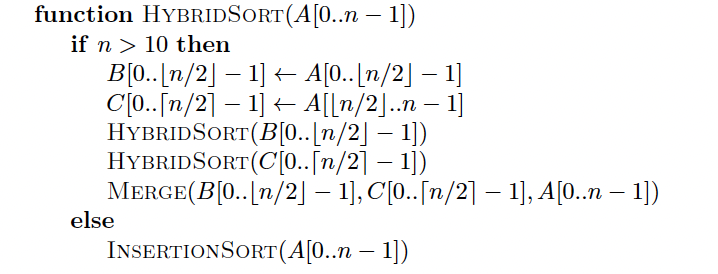Question
function HYBRIDSORT (A[0..n-1]) if n > 10 then B[0.. [n/2] 1] A[0..[n/2] - 1] C[0..[n/2] -1] A[[n/2]..n 1] HYBRIDSORT (B[0..[n/2] 1]) HYBRIDSORT(C[0..[n/2] - 1])


function HYBRIDSORT (A[0..n-1]) if n > 10 then B[0.. [n/2] 1] A[0..[n/2] - 1] C[0..[n/2] -1] A[[n/2]..n 1] HYBRIDSORT (B[0..[n/2] 1]) HYBRIDSORT(C[0..[n/2] - 1]) MERGE(B[0.. [n/2] 1], C[0..[n/2] 1], A[0..n 1]) INSERTIONSORT(A[0..n - 1]) else (a) Explain why this sorting algorithm takes less amount of time compared to INSERTIONSORT, when sorting a large collection of elements. (b) Explain why this sorting algorithm takes less amount of time compared to MERGESORT, when sorting a large collection of elements.
Step by Step Solution
3.44 Rating (154 Votes )
There are 3 Steps involved in it
Step: 1
The image contains a pseudocode for a sorting algorithm called HybridSort and two questions that prompt explanations regarding its performance compare...
Get Instant Access to Expert-Tailored Solutions
See step-by-step solutions with expert insights and AI powered tools for academic success
Step: 2

Step: 3

Ace Your Homework with AI
Get the answers you need in no time with our AI-driven, step-by-step assistance
Get StartedRecommended Textbook for
Discrete and Combinatorial Mathematics An Applied Introduction
Authors: Ralph P. Grimaldi
5th edition
201726343, 978-0201726343
Students also viewed these Programming questions
Question
Answered: 1 week ago
Question
Answered: 1 week ago
Question
Answered: 1 week ago
Question
Answered: 1 week ago
Question
Answered: 1 week ago
Question
Answered: 1 week ago
Question
Answered: 1 week ago
Question
Answered: 1 week ago
Question
Answered: 1 week ago
Question
Answered: 1 week ago
Question
Answered: 1 week ago
Question
Answered: 1 week ago
Question
Answered: 1 week ago
Question
Answered: 1 week ago
Question
Answered: 1 week ago
Question
Answered: 1 week ago
Question
Answered: 1 week ago
Question
Answered: 1 week ago
Question
Answered: 1 week ago
Question
Answered: 1 week ago
Question
Answered: 1 week ago
Question
Answered: 1 week ago
Question
Answered: 1 week ago
View Answer in SolutionInn App



